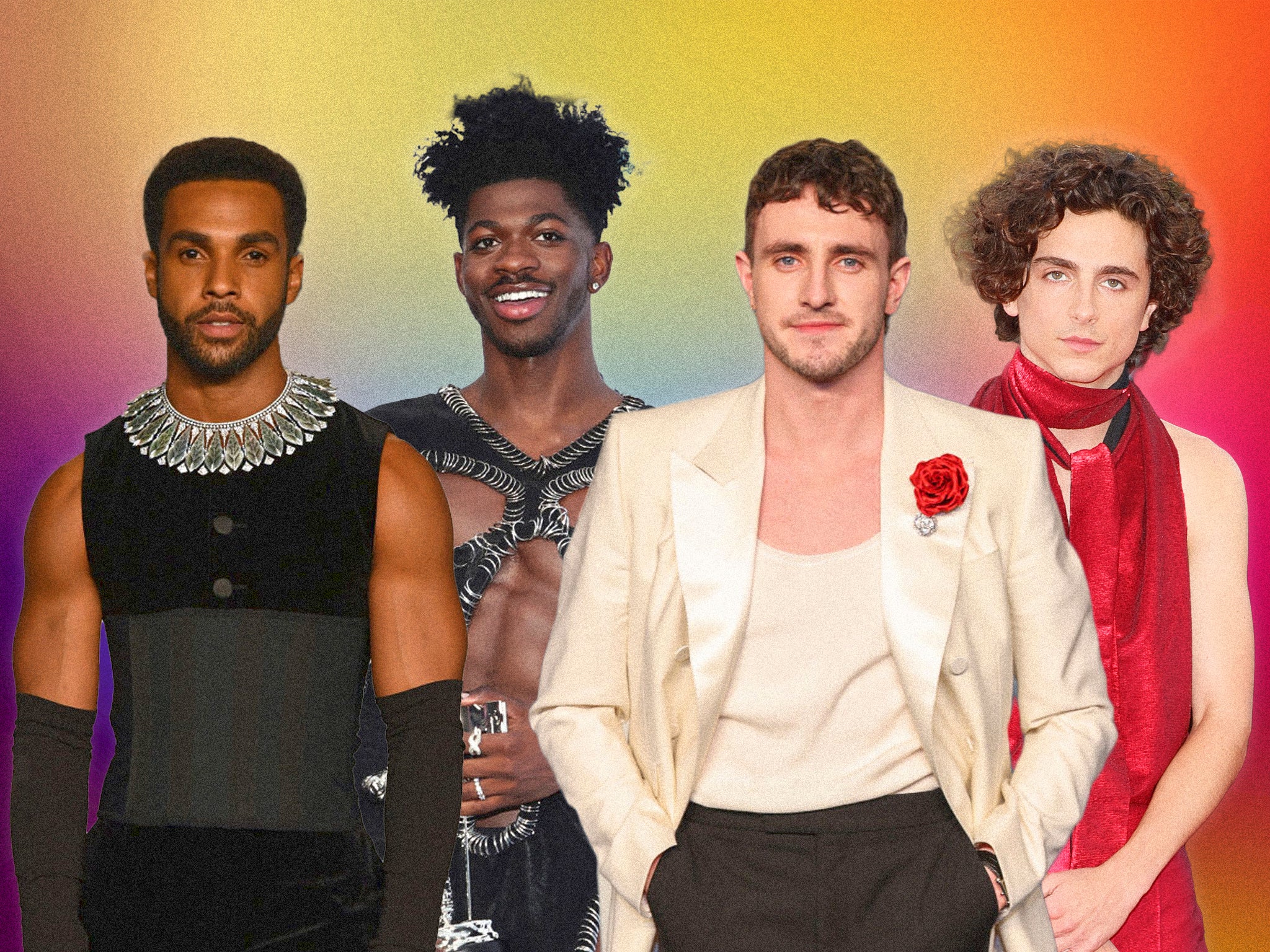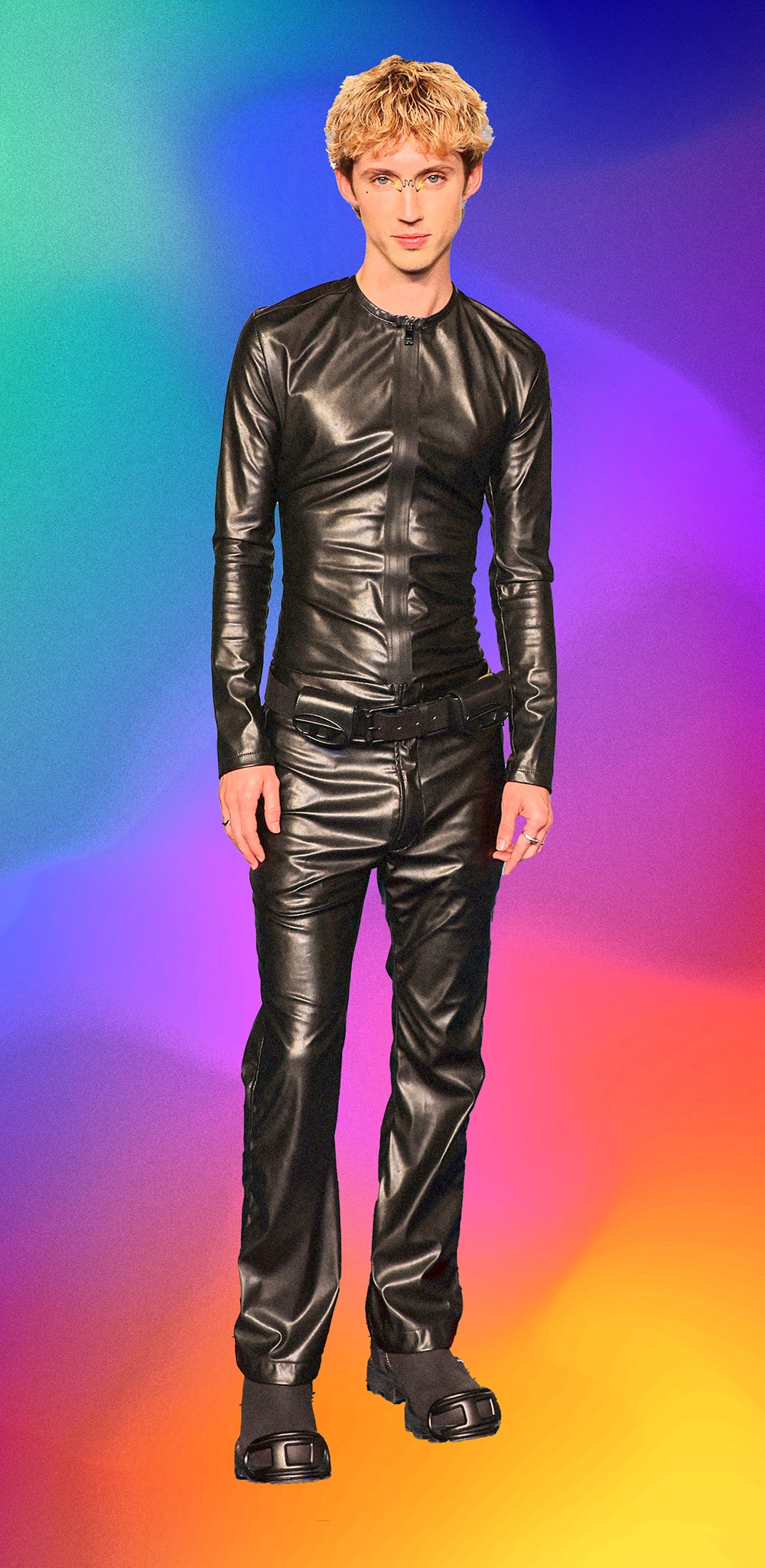Subversive? Dangerous? Boring?: How the red carpet became a barometer for modern masculinity
From Timothée Chalamet in a backless suit to Lucien Laviscount’s corsage and evening gloves, red carpet menswear has become as much an exercise in mass marketing as an opportunity to dismantle gender rules, writes Joseph Bobowicz

For a masterclass in masculinity, look no further than the red carpet, an international circuit of events charting the good, the bad and the ugly of manhood today. A stage for fashion designers to present their vision of the male zeitgeist, the red carpet is more than an exercise in mass marketing, but also an opportunity to chime in on gender identity – nowadays, to the point of exhaustion. Whether it’s Harry Styles in a Gucci diamante-studded jumpsuit, Billy Porter in a Christian Siriano gowned tuxedo or Timothée Chalamet in an Haider Ackermann backless crimson suit, looks that brush against gender are now par for the course alongside a brand’s more classic displays of elegance.
While we might have reached camp fatigue, it’s worth noting that the abundance of kitsch and dandy looks on the red carpet are a relatively new phenomenon. Indeed, before 2017, you would be hard-pressed finding anything wilder than a scooping lapel or – clutches pearls – a choice hue on a guest’s dinner jacket. Yes, the likes of David Bowie, Little Richard and Boy George were pushing their luck yonks ago, but their scrapes with femininity were exceptions to the rule. Today, it’s a whole different game.
Academics have been picking scabs in masculinity since Oscar Wilde was flicking his literary wrists. In the last half decade, though, every man (sorry!) and their dog has been reckoning with the term, from CEOs warning against the effects of “toxic masculinity” on leadership to podcasters encouraging a new, vulnerable kind of masculinity to improve mental health. Elsewhere, the term has titled exhibitions such as Barbican’s Masculinities: Liberation Through Photography (2020) and the V&A’s blockbuster Fashioning Masculinities (2022), all while our blue-screened devices have blazed with discourse about it and its caricatures – be it gouty politicians, twentysomething bitcoin bros or aggrieved incels. Nowhere, though, has masculinity been as talked about as on the red carpet.
“I think it’s largely down to their inherently spectacular nature,” says i-D’s fashion features editor, Mahoro Seward. “Though they may not be on screen or stage, the people that typically walk red carpets are, to their audiences, still characters. The managers, publicists and stylists responsible for these characters are critically aware of that and will consciously build a celebrity’s image in a way they think appeals to that persona’s audience – whether that’s by kowtowing to convention or intentionally pushing at the boundaries.”
To Seward’s point, red carpet events are consistently thronged by neatly suited gentlemen in velvet tuxedos alongside those who defy protocol. The result is one of contrast. “I think menswear on the red carpet is still rooted in the suit,” says Paul Toner, 10 magazine’s features and online editor. “However, stars are turning to brands that cleverly subvert classic tailoring to make it more interesting, like Virgil Abloh did at Louis Vuitton, or Kim Jones does at Dior. Some stars, such as Timothée Chalamet and Lil Nas X, have taken it a step further, treating the red carpet as a place for real fashion moments.”
On the one hand, you have Lil Nas X in cropped, Barbie-pink cowboy leathers by Versace; on the other, you have Daniel Craig in yet another Tom Ford tuxedo – groundbreaking! Between these poles, subtler twists on the archetype appear, like Paul Mescal’s 2023 Oscars ensemble: a custom Gucci oversized jacket and flared trews, plus the flourish of a Cartier earring, brooch and rosette. Granted, Mescal’s look won’t have traditionalists quaking in their boots, but his status as the approachable, wholesome boy next door makes these effete touches all the more significant. “As a male, wearing anything even slightly ‘off’ the norm garners you a huge amount of publicity,” says creative consultant Cozette McCreery. “No one is going to post or report on you if you’re dressed ‘normally.’”
Among ubiquity, even the lightest tweak stands out. To paraphrase Judith Butler’s thesis in Gender Trouble, it’s about the cultural maintenance and desecration of norms. Because men, by and large, wear black tie on the red carpet, this became coded as male. Add to this that men were often assumed to be heterosexual, and we see how the noble persona of a chaperone walking his female date held sway. With this came another restriction: don’t drown out the woman. As a lady, it went, she would perform a frilled-up rendition of femininity, her walker barely noticeable. Naturally, with this antiquated pageantry as a backdrop, difference from the norm comes into sharp focus.
Sam Smith is seen as dangerous to heteronormative masculinity, because they destabilise it
That said, in an industry as closely followed as showbiz, gender-bending also arouses irritation or suspicion. Elsewhere, queer-identifying celebrities have even retreated into noticeably subtle or straight-coded dress in an ironic rejection of camp’s co-option. Case in point: Frank Ocean’s all-black Prada ensemble at the 2019 camp-themed Met Gala.
In this environment, plays on traditional masculinity must feel effortless to land. “Sam Smith’s recent red-carpet looks, while clearly intended to slay and enrage in equal measure, are also an exaggerated version of the singer’s off-stage style, which they have used to navigate a journey of gender exploration and expression,” says Westminster University’s Professor Andrew Groves. Smith’s forays into femininity began with a glimpse of heels, then developed into lacey blouses below tailoring, before eventually peaking in a sumptuous Valentino cape at the Grammys this year. Their style journey has felt less like feminine cosplay and more a flowering of their true self. “This is why they are seen as far more dangerous to heteronormative masculinity, because they destabilise it.”
Now, the pendulum is swinging. As gender fluidity on the red carpet becomes de rigueur, the B-list has followed suit. “I think it’s set a precedent for other guys who want to be considered successful dressers, so we’ve seen Love Islanders start to wear skeleton blouses,” says Dazed’s fashion writer Daniel Rodgers. “But celebrities with more esteem and more social capital don’t want to look like that anymore; they don’t want to look like you.”
Rodgers’ point was echoed at last weekend’s Oscars, where the menswear was visibly dialled back. Much like the AW23 collections, a feeling of reduction and conservativism was present, perhaps a correlation to inflation, but also, the right-wing backlash against non-conforming displays of gender identity.
“The recent Golden Globes and the Grammys saw men get more in touch with their playful sides, but I think there’s a certain level of respect to the old Hollywood dress code that stipulates what people should wear to the Oscars,” says Zak Maoui, GQ’s style editor. “To support this, I think taking a look at the Vanity Fair [after-party] shows that men are still pushing boundaries – Lucien Laviscount, Manu Rios, Troye Sivan...”

It’s true. These looks were undeniably risqué – but camp, they were not. For Laviscount, a Dolce & Gabbana velvet waistcoat cinched with corset and paired with evening gloves; for Rios, Ann Demeulemeester’s knee-high leather boots, black dinner jacket and apron-tied dress shirt; for Sivan, a Diesel latex two-piece that would have been better placed in a fetish party. Costume aesthetics were nowhere to be seen, replaced with a louche, softened and sexed-up blend of masculinity, instead of a dragged-up cock in a frock.
The rub? Like all gender-related debates, it goes back to Butler. Now, a cock in a frock is just another sealed and culturally intelligible archetype men can embrace on the red carpet, which means it’s not all that subversive. Maybe the seeds of menswear’s next half-decade rebellion lie in fetish and sex appeal, as the most eyebrow-raising looks at the Vanity Fair party might suggest. Certainly, they felt exciting. But will they one day feel passé as men find other ways to test masculinity? One thing is sure: the red carpet will always be the best place to find them.



Join our commenting forum
Join thought-provoking conversations, follow other Independent readers and see their replies
Comments